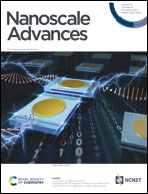Flexible and transparent electrodes imprinted from metal nanostructures: morphology and opto-electronic performance†
Abstract
We directed the self-assembly of nanoscale colloids via direct nanoimprint lithography to create flexible transparent electrodes (FTEs) with metal line widths below 3 μm in a roll-to-roll-compatible process. Gold nanowires and nanospheres with oleylamine shells were imprinted with soft silicone stamps, arranged into grids of parallel lines, and converted into metal lines in a plasma process. We studied the hierarchical structure and opto-electronic performance of the resulting grids as a function of particle geometry and concentration. The performance in terms of optical transmittance was dominated by the line width. Analysis of cross-sections indicated that plasma sintering only partially removed the insulating ligands and formed lines with thin conductive shells and a non-conductive core. We provide evidence that the self-assembly of high-aspect nanowires can compensate for defects of the stamp and substrate irregularities during imprinting, while spheres cannot. The wire-based electrodes thus outperformed the sphere-based electrodes at ratios of optical transmittance to sheet resistance of up to ≈ 0.9% Ωsq−1, while spheres only reached ≈ 0.55% Ωsq−1.

- This article is part of the themed collection: Nanomaterials for printed electronics


 Please wait while we load your content...
Please wait while we load your content...